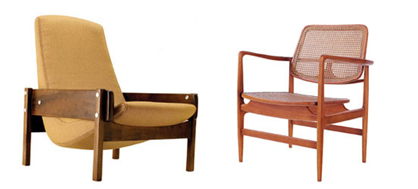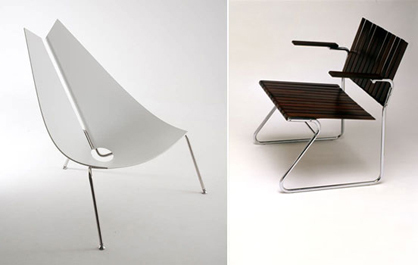Brazilian Design
Text by Nora Schmidt
Berlin, Germany
04.01.08
Brazilian design can look back on a long history. And although it was initially strongly influenced by European design ideas, it has since developed.
Brazilian design can look back on a long history. And although it was initially strongly influenced by European design ideas, it has since developed its own, unmistakably Brazilian aesthetic.
Poltrona Vronka, 1962; Oscar Armchair, 1956 by Sergio Rodrigues
One of the first Brazilians who turned away from the predominantly traditionalist style was Joaquim Tenreiro (1906-1992), the son of a Portuguese furniture maker and an early advocate of modernism. He is regarded as the founder of the modern Brazilian concept of design. His furniture designs dating back to the 1940s are manufactured mainly from materials, which are characteristic for the country and they show that Tenreiro adapted their design - entirely in line with the functionalists - to the economic, geographical and social circumstances in Brazil, in this way giving Brazilian design an identity of its own. Oscar Niemeyer, who will by the way celebrate his 100th birthday in December, proved to be a strong admirer of Tenreiros and furnished his buildings with the designer's furniture. Another icon is Sérgio Rodrigues, born in 1927, who aroused international interest in Brazilian furniture design with his "Poltrona mole" at the beginning of the Sixties. Rodrigues created an unique and innovative design vocabulary, whose nonchalance distinguished it from the aesthetic standards of that time - thanks to his work, Brazilian design became an international trend. In 2001 the Brazilian manufacturer LinBrasil got the production rights for his designs and meanwhile produces 28 works from Rodrigues.
The Hochschule für Gestaltung Ulm, cultivated the close relationship between the Brazilian and the European design community. Because of its international orientation it has long maintained a dialogue with Brazilian students and has had considerable influence on their concepts of design. When in 1963 the first Brazilian school of design, the Escola Superior Desenho Industrial (ESDI) was founded in Rio de Janeiro, among others by former Ulm students, it was on the basis of the Ulm methodology and interdisciplinary approach.
Fenda Chair by Ilse Lang, Farodesign; 20R chair by Perdo Useche
Brazil can now look back on more than half a century of modern design history. There are schools of design in every town of any significance, and Brazilian design has been awarded with range of international prizes. Nevertheless, the response of the media has been relatively modest, except in the case of the designer duo Fernando and Humberto Campana, who have enjoyed enormous international attention since the early Nineties. The two brothers have taken the social and ecological circumstances of their hometown São Paulo as an opportunity to occupy themselves with designs and furniture as a product which can be recycled. Among others they design for quality manufacturers like Edra in Italy or Habitart in Brazil. However, in addition to the Campana brothers, with their prominent media presence, there is still a large number of other manufacturers and designers who have received, despite the quality of their work, little international attention. The minimalist and delicate Tensor series designed by Pedro Useche, who was born in Venezuela, or the perfectly formed Fenda chair by Ilse Lang, who produces her designs under the Farodesign label, are good examples of work beyond the European horizons, that are worth exploring. In our new special topic of 'Design from Brazil' we would like to present a selection of our personal favourites.





